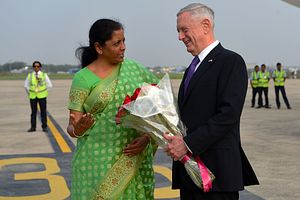The defense relationship between the United States and India, on a steady upward trajectory this decade, crossed an important milestone last week. During the first-ever “two-plus-two” meeting of the two countries’ top defense and diplomatic officials, India and the United States concluded a third so-called foundational agreement to facilitate closer defense cooperation.
They signed a Communications Compatibility and Security Agreement (COMCASA), which, according to the joint statement released after the meetings, “will facilitate access to advanced defense systems and enable India to optimally utilize its existing U.S.-origin platforms.” COMCASA follows the signing of the U.S.-India Logistics Exchange Memorandum of Agreement (LEMOA) in 2016 and the General Security of Military Information Agreement (GSOMIA) in 2002.
The U.S.-India COMCASA — known earlier by its generic name CISMOA, or a Communication Interoperability and Security Memorandum Agreement — requires India to safeguard sensitive and secure U.S.-sourced military communication equipment and, in turn, facilitates Indian use of previously restricted communication channels to enable closer interoperation between U.S. and Indian military assets as well as those of friendly armed forces that have also concluded a similar agreement with the United States. Even after years of bilateral military exercises, without COMCASA, Indo-U.S. military communications were able to use a limited feature set of the U.S. CENTRIX (Combined Enterprise Regional Information Exchange) communication system. That limit will no longer apply.
Outside of interoperability, COMCASA will also open up the possibility of Indian military units gaining access to a secure Common Tactical Picture, which would allow, for instance, Indian Navy and Air Force surveillance aircraft and fighters to receive data from U.S. and friendly counterparts during exercises or operations. Additionally, given India’s access to previously restricted U.S. defense technology exports following its 2016 designation as a Major Defense Partner, COMCASA will open up the possibility of India importing U.S. systems unencumbered by possible limitations on guidance, communication, and sensor technologies.
Apart from the conclusion of COMCASA, the two-plus-two meeting saw defense consultations between the two sides on India’s pending purchase of a Russian S-400 air defense system, a move that could trigger U.S. sanctions, and regional issues, including India’s energy imports from Iran. Later this year, the United States will activate a second round of sanctions after the May 2018 decision by U.S. President Donald J. Trump to withdraw from the 2015 Joint Comprehensive Plan of Action, the agreement that capped Iran’s nuclear program in exchange for sanctions relief.
New Delhi and Washington will likely work toward the conclusion of a final foundational agreement on defense, known as the Basic Exchange and Cooperation Agreement for Geo-spatial Cooperation, or BECA. That agreement would outline protocols for the sharing of mapping and other geospatial data securely between the two sides.

































